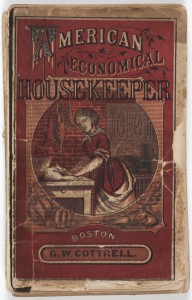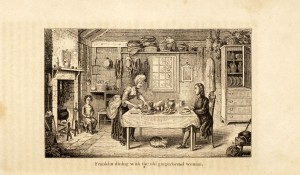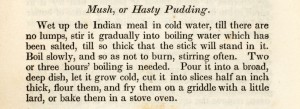
Ever wonder what Susanna was chewing on in Stephen Foster’s famous folk song? Curious about how women occupied their days at home in early America? Interested in learning more about the relationship between early American housewives and their maids? Whether you are interested in the history of American cooking, women’s history, domestic history, or the recipes for antiquated baked goods mentioned in early American folk music, the American Antiquarian Society’s cookbook collection has a wealth of information on many cooking related topics. Small in size and well worn, these tomes bear uncommon witness to our social as well as culinary past.
The makings of women’s history in America can be found in these books alongside ingredients for archaic-sounding dishes such as Boiled Indian Pudding and English Curd Pie. Many of these books contain prefaces and chapters recording first hand accounts of household tasks women performed and accounts of their opinions on topics as varied as education and household economy. In Maria Rundell’s American Domestic Cookery published in Baltimore in 1822 [online catalog record], she gives a brief sketch of social roles for women in early America:
To attend to the nursing, and at least, early instruction of children, and rear a healthy progeny in the ways of piety and usefulness: – to preside over the family, and regulate the income allotted to its maintenance: to make home the sweet refuge of a husband fatigued by intercourse with a jarring world: to be his enlightened companion and the chosen friend of his heart; these, these are woman’s duties! (Rundell 7).
This passage outlines gender roles for men and women in keeping with the conception of separate spheres, women kept homes running happily and smoothly while men engaged in commerce in the outside world. Yet, we also learn that women were in involved in the disposal of household income from this passage. Further evidence of female economic skill is put forth in the passage, “Many families have owed their prosperity full as much to the propriety of female management, as to the knowledge and activity of the father” (Rundell 11). Rundell further notes, “can any one urge that the female mind is contracted by domestic employ?” (Rundell 8) Behind this statement we can hear the voices of those Rundell addresses. Some people in early America were concerned that domestic duties, or perhaps sole engagement with them to the exclusion of more intellectual endeavors, had an adverse affect on women’s minds.

In Sarah Josepha Hale’s The Ladies’ New Book of Cookery, published in New York in 1852 [online catalog record], she notes that if mothers pamper their sons’ appetites they contribute to their future selfishness and profligacy. She more sweepingly characterizes the integral nature of women’s roles in early American society, “the duty which Nature has assigned her, that of promoting the health, happiness and improvement of her species” (Hale vii). Here, Hale echoes the commonly held view that women had a morally improving effect on society. Hale also notes that cooking is “the medium of social and domestic happiness” (Hale iii). It is clear from this cookbook that women in early American society regarded their domestic endeavors with philanthropic gravity.
In Lydia Maria Child’s The American Frugal Housewife [online catalog record], she asserts the importance of women’s roles in early America:
There is no subject so much connected with individual happiness and national prosperity as the education of daughters…The greatest and most universal error is, teaching girls to exaggerate the importance of getting married; and of course to place an undue importance on the polite attentions of gentlemen. (Child 91)
Here, we learn that early Americans thought women could have a positive impact on society outside of matrimony.
Cookbook composition also enabled women to find a literary voice at a time when it was less socially acceptable for women to become writers. In Eliza Smith’s The Compleat Housewife [online catalog record], she assumes the posture of a historian and a fiction writer at the beginning of her cookbook. Her book commences with a preface containing a short history of cooking, in which she discusses early cooks mentioned in the Bible. Smith also comments on the current literary mode of using prefaces: “It being grown as unfashionable for a Book now to appear in Publick without a Preface, as for a Lady to appear at a Ball without a Hoop-Petticoat.” She writes of her book “if it either instruct or divert, I shall be satisfied, if you are so.” Some women explored different forms of verbal expression through cookbook prefaces.
And what about the recipes themselves you might ask? Much of the fare in early American cookbooks remains the same as it does today. Influence of European cookery, Native American cookery, and Creole cookery in the south can also be traced. British influence existed in most recipes and notably in “English Plum Pudding” and “English Curd Pie.” Native American influence can be found in recipes calling for corn, Indian meal, and medicinal barks and herbs. Other recipes have a distinctly American ring: Fried Hominy, Pennsylvania Flannel Cakes, Kentucky Corn Dodgers, Cranberry Pie, Boiled Indian Pudding, Green Corn Pudding, and New England Pumpkin Pie.
A confection called Pilgrim Cake, which was reputedly concocted by “our pilgrim and pioneer forefathers,” simply called for flour, butter, and water, according to Miss Beecher’s Domestic Recipe Book [online catalog record] (Beecher 98). It was rolled out an inch thick and baked under ashes in the hottest part of the hearth. The ashes were scraped off before eating of course!

On a more whimsical note, Catherine Beecher’s recipe for Hasting Pudding provides historical verification of the thickness of hasty pudding as captured in the lyrics of “Yankee Doodle”: “And there we saw the men and boys / As thick as hasting pudding.” According to this recipe, one stirred hasting pudding “till so thick that the stick will stand in it” (Beecher 108).
An examination of early American cookbooks reveals a cornucopia of information regarding the history of early American cooking and the cultural and social history with which such history is interwoven. So, the next time you stop by the American Antiquarian Society to research women’s history or domestic history or the history of cooking, we suggest you explore the wide array of small tomes in the cookery book collection, well worn by generations of American housewives. And as for tearful Susanna’s buckwheat cakes, they were made from a mixture of buckwheat flour, milk, salt, yeast, and Indian meal.
How to Find Cookbooks at AAS:
AAS’s cookbooks are fully cataloged online. Searching AAS’s online catalog for the call number “Cook Books” will give you a list of the main collection, which consists of over 1,000 cookbooks published after 1820. Earlier cookbooks can be found by searching for the genre term “cookbooks” and then sorting the list by date. There is even a manuscript collection of handwritten cookbooks with an online contents list.
Further Reading:
Beecher, Catherine. Miss Beecher’s Domestic Receipt Book. New York: Harper & Brothers, 1846.
Child, Lydia. The American Frugal Housewife. 10th ed. Boston: Carter and Hendee, 1832.
Hale, Sarah Josepha. The Ladies’ New Book of Cookery. 5th ed. New York: H. Long & Brother, 1852.
Rundell, Maria. American Domestic Cookery. Baltimore: Fielding Lucas, 1822.
Smith, Eliza. The Compleat Housewife. Williamsburg, Virginia: William Parks, 1742.
